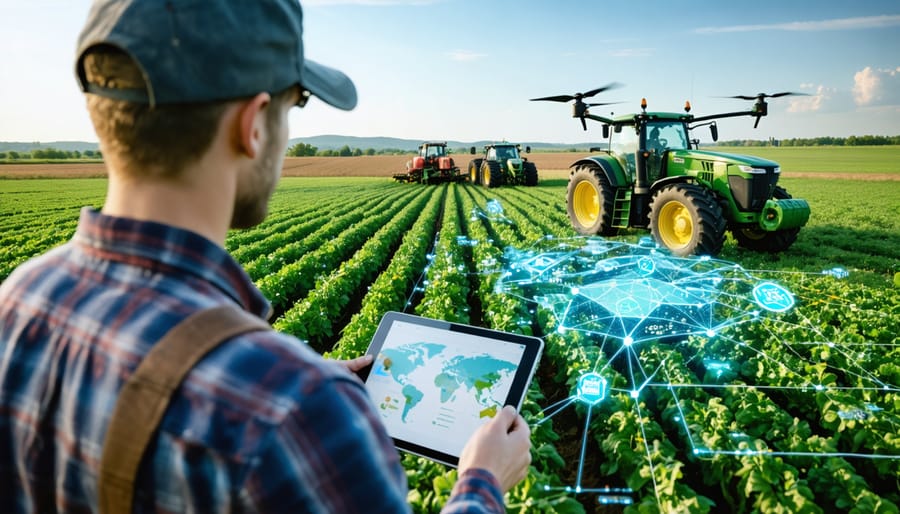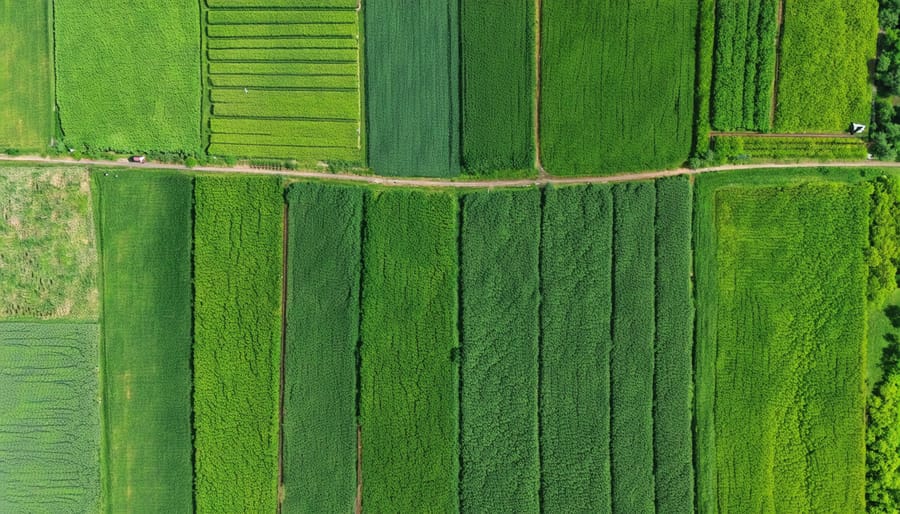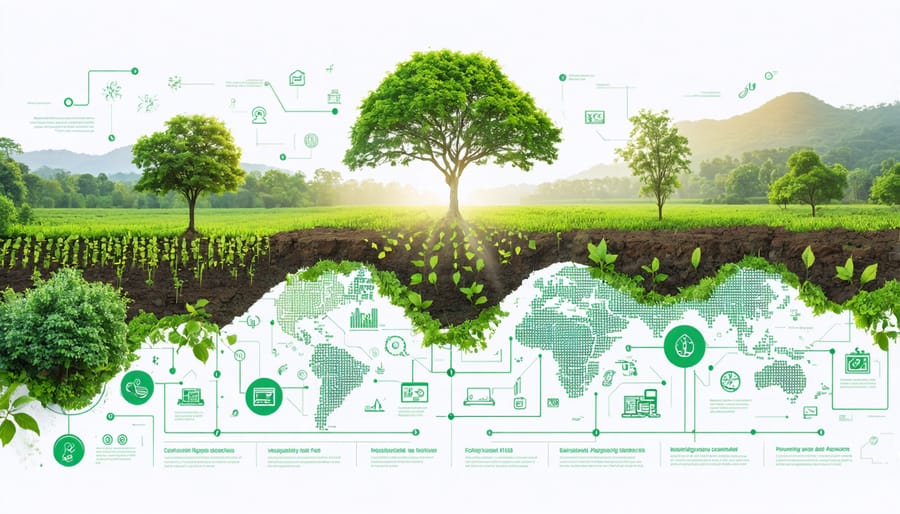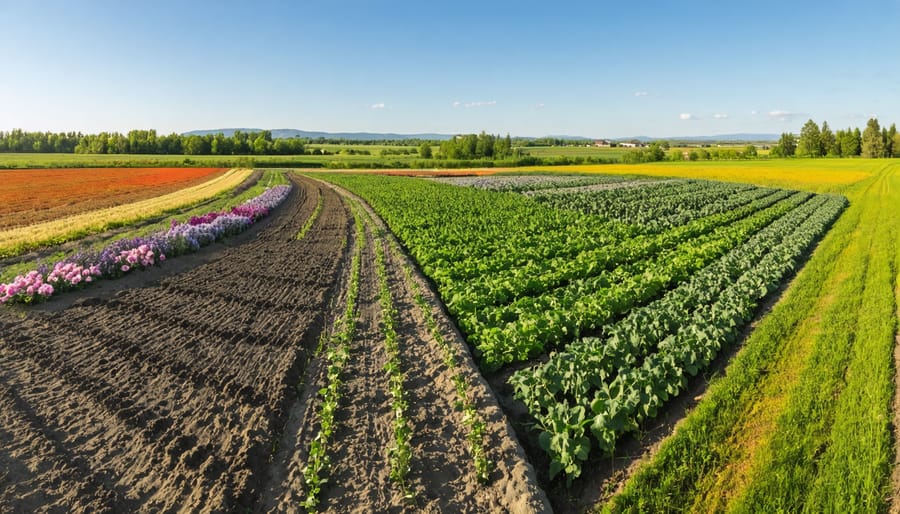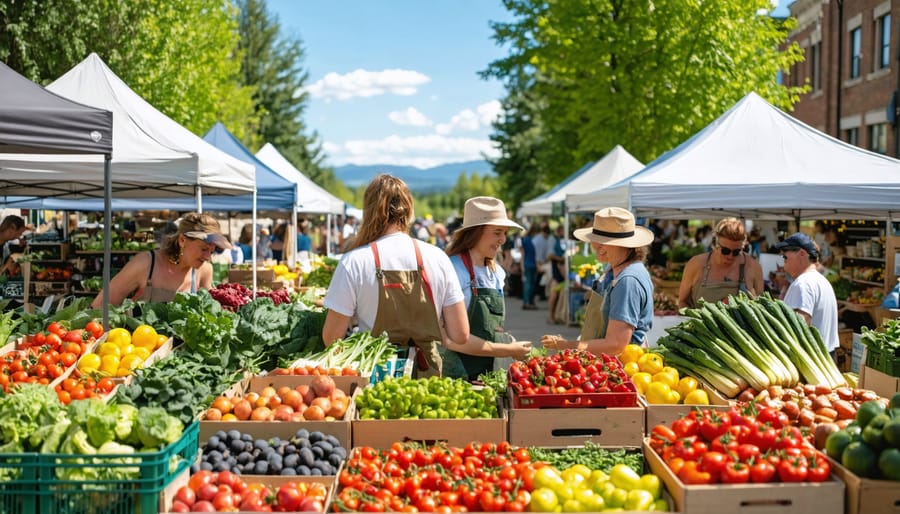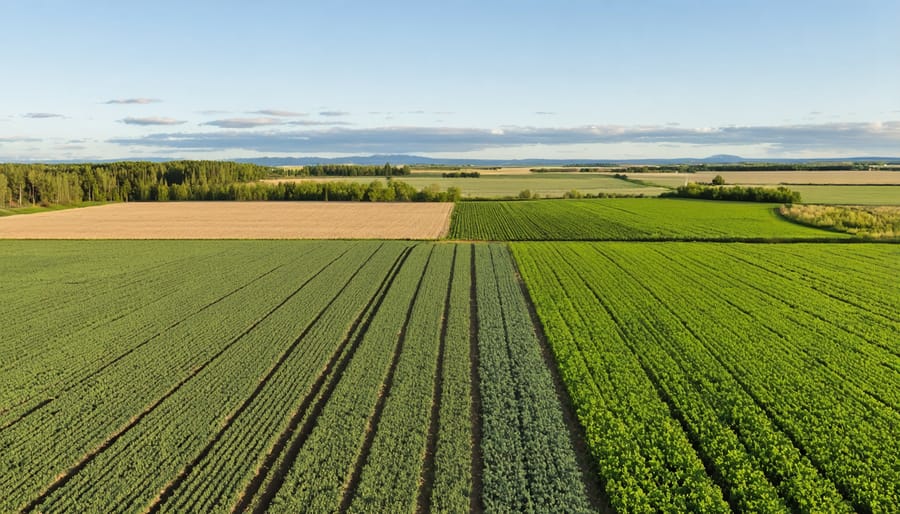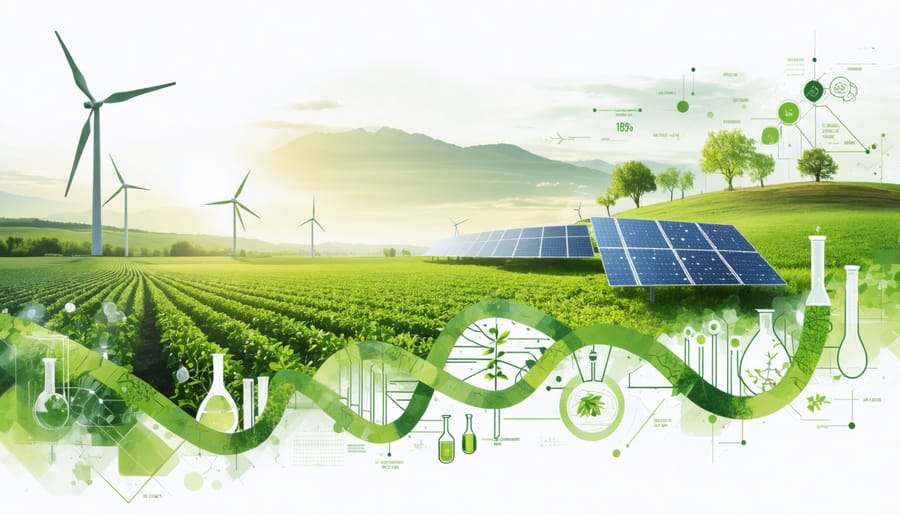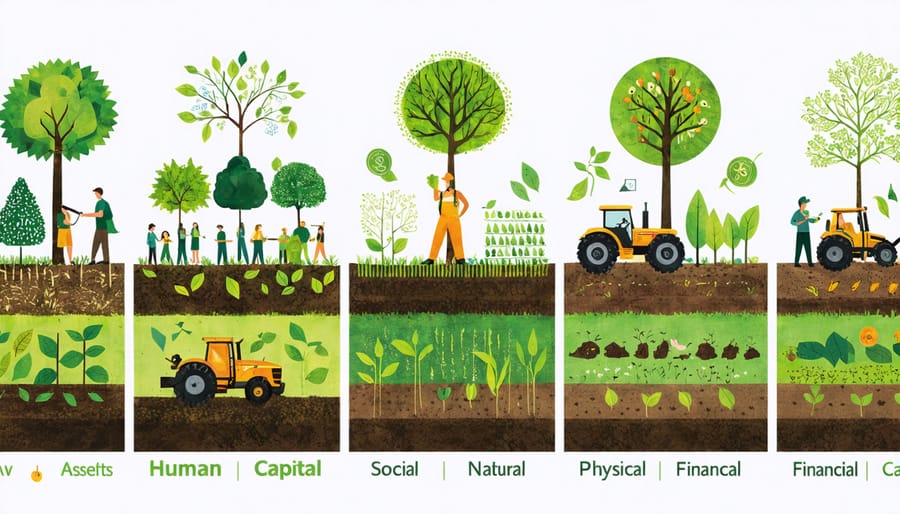Precision agriculture revolutionizes farming by integrating data-driven technology with traditional agricultural practices to maximize yield while minimizing resource waste. This modern approach combines GPS mapping, soil sensors, automated equipment, and real-time analytics to transform every hectare into its most productive state. Canadian farmers, particularly in Alberta’s diverse agricultural landscape, are increasingly adopting these smart farming techniques to combat rising input costs and weather uncertainties.
By leveraging satellite imagery, soil sampling, and yield monitoring, precision agriculture enables farmers to apply exactly what’s needed, where it’s needed, when it’s needed. Rather than treating fields uniformly, this targeted approach creates detailed management zones based on soil composition, moisture levels, and crop health indicators. The result is a more sustainable and profitable operation that reduces environmental impact while boosting bottom-line returns.
For Alberta’s agricultural community, precision agriculture represents more than just technology adoption—it’s a fundamental shift toward smarter resource management and enhanced food production efficiency. As global markets demand more sustainable farming practices, this data-driven approach positions Canadian farmers at the forefront of agricultural innovation.
The Building Blocks of Precision Agriculture
GPS and Mapping Technologies
GPS and mapping technologies form the backbone of modern precision agriculture in Canada. Using satellite-based positioning systems, farmers can pinpoint exact locations in their fields with accuracy down to 2.5 centimetres. This precise positioning enables the creation of detailed field maps that showcase variations in soil types, moisture levels, and crop health across different areas.
Many Alberta farmers are now using RTK (Real-Time Kinematic) GPS systems, which provide the highest level of accuracy for field operations. These systems work alongside various mapping tools to create comprehensive field management zones. Popular tools include yield monitors, which track harvest data, and remote sensing technologies that capture detailed aerial imagery of crop conditions.
Digital field maps integrate multiple data layers, including soil sampling results, topography, and historical yield data. This information helps farmers make informed decisions about input application rates and identify areas requiring specific attention. Modern mapping software can also generate prescription maps for variable-rate applications, ensuring resources are used efficiently across different field zones.
For beginning precision agriculture adopters, basic GPS guidance systems offer an excellent starting point, with the option to upgrade to more sophisticated mapping capabilities as needed.
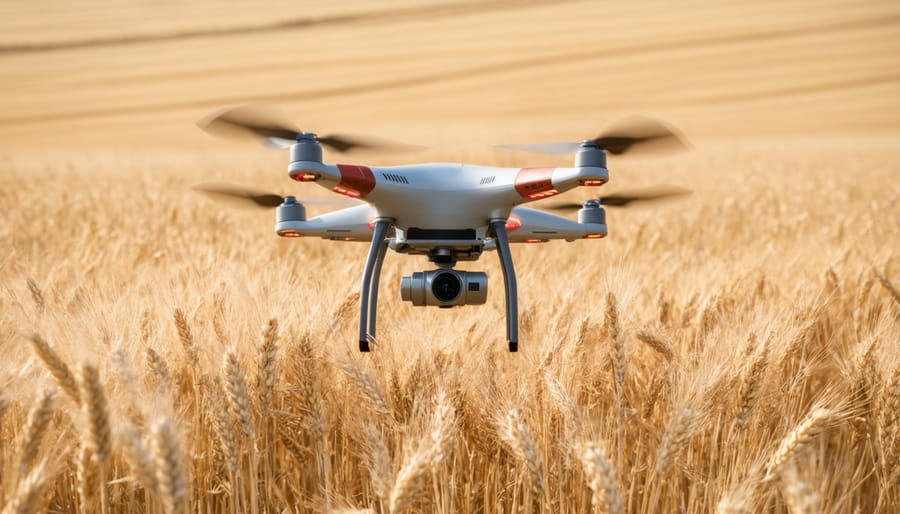
Sensor Networks and Data Collection
Modern precision agriculture relies heavily on a network of sophisticated sensors and data collection systems that work together to provide farmers with detailed insights about their operations. Across Alberta’s varied landscape, farmers are using soil moisture sensors, weather stations, and GPS-enabled equipment to gather real-time data about their fields.
These monitoring systems typically include ground sensors that measure soil conditions, including moisture levels, temperature, and nutrient content. Aerial sensors, mounted on drones or satellites, capture multispectral imagery that reveals crop health patterns and stress areas that might not be visible to the naked eye.
Many Alberta farmers are now implementing wireless sensor networks that transmit data directly to their smartphones or farm management systems. These networks can monitor multiple field parameters simultaneously, from crop growth stages to pest presence, helping farmers make timely decisions about irrigation, fertilization, and pest control.
Vehicle-mounted sensors on tractors and other farm equipment provide additional data layers, measuring factors like yield variations and soil compaction during regular field operations. This comprehensive monitoring approach ensures that farmers have access to precise, actionable data for making informed management decisions.
Farm Management Software
Modern farm management software platforms are essential tools in precision agriculture, revolutionizing farm management through integrated data analysis and decision support. These digital solutions help Alberta farmers track everything from soil conditions and crop health to equipment efficiency and yield predictions in real-time. Popular platforms like Climate FieldView and Trimble Ag Software enable farmers to create detailed field maps, monitor weather patterns, and manage variable-rate applications from their smartphones or tablets. The software consolidates data from various precision agriculture tools, including GPS guidance systems, yield monitors, and soil sensors, providing actionable insights for better decision-making. Many platforms also offer financial tracking features, helping farmers optimize their operations while maintaining detailed records for regulatory compliance and sustainable farming practices.

Economic Benefits for Alberta Farmers
Resource Optimization
Precision agriculture’s resource optimization strategies significantly reduce input costs while maintaining or improving crop yields. By leveraging data-driven decisions, Alberta farmers typically see a 15-30% reduction in fertilizer usage through variable rate application technologies. These systems ensure inputs are applied only where and when needed, eliminating waste and overuse.
Water management through precision irrigation has shown particular promise in southern Alberta’s semi-arid regions, with farmers reporting up to 25% reduction in water usage while maintaining optimal soil moisture levels. Smart sensors and soil mapping enable targeted irrigation schedules, preventing both under and over-watering while reducing energy costs associated with pumping.
Fuel efficiency improves markedly with precision guidance systems, as equipment operators can minimize overlap during field operations. Local studies show fuel savings of 10-15% when using auto-steering technology, while reducing operator fatigue and extending equipment life through more efficient operation.
Labour costs decrease as automation handles routine tasks more efficiently. GPS-guided equipment can work longer hours with greater accuracy, while automated monitoring systems alert farmers to potential issues before they become costly problems. Many Alberta farmers report labour savings of 20-30% after implementing precision agriculture systems, allowing them to redirect workforce resources to other critical farm operations.
Yield Improvement Metrics
Recent data from Alberta farms demonstrates the significant impact of precision agriculture on yield improvement. A 2022 study conducted across central Alberta showed that farms implementing precision agriculture techniques experienced an average yield increase of 12% in canola and 15% in wheat production compared to traditional farming methods.
In Lacombe County, farmer Dave Peterson reported a 20% reduction in input costs while achieving a 17% increase in barley yields after adopting variable rate technology and GPS-guided equipment. Similar success was documented in Leduc, where precision soil sampling and targeted fertilizer application resulted in an average 14% improvement in field pea yields across 15 participating farms.
The Alberta Precision Agriculture Project, tracking 50 farms over three years, revealed that farms using soil moisture sensors and weather stations for irrigation management saw water efficiency improvements of up to 30%, while maintaining or increasing crop yields. In particular, potato farmers in southern Alberta reported yield increases of 8-10% while reducing water usage by 25%.
These improvements aren’t limited to large operations. Small-scale farms in the Peace Region implementing basic precision agriculture tools, such as yield monitoring and GPS guidance systems, documented average productivity gains of 9% across various crop types, demonstrating the scalability of these technologies for operations of all sizes.
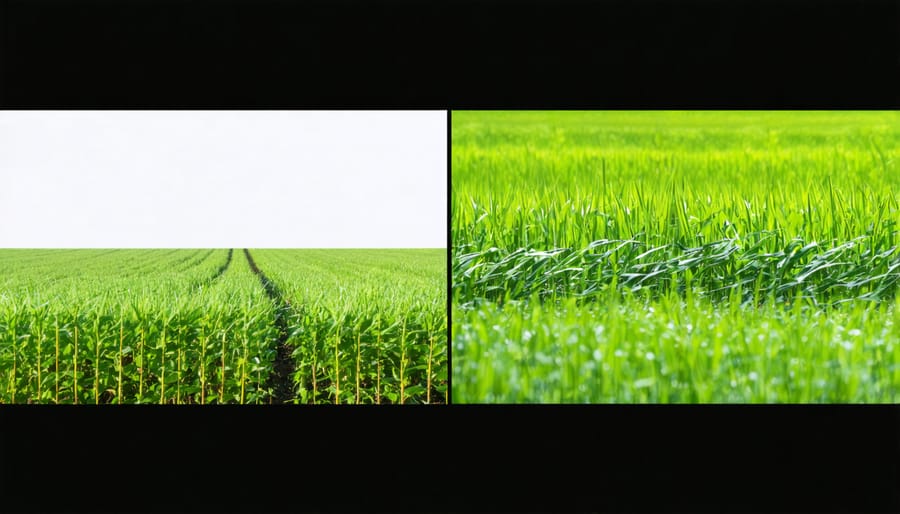
Return on Investment Analysis
Recent studies across Alberta demonstrate that precision agriculture investments typically yield returns within 2-3 growing seasons. Local farmer James McKenzie from Lethbridge County reported a 15% increase in crop yields and a 20% reduction in input costs after implementing GPS-guided tractors and variable rate technology. These improvements are key factors in improving farm profitability through precise resource management.
A comprehensive analysis of 50 Alberta farms showed that initial investments ranging from $20,000 to $75,000 in precision agriculture technology resulted in average annual savings of $35 per hectare. For a typical 1,000-hectare operation, this translates to $35,000 in yearly cost reductions through optimized input use.
The Red Deer Agricultural Society documented that farms utilizing soil mapping and variable rate application reduced fertilizer usage by 25% while maintaining or increasing yields. Environmental benefits, including reduced soil compaction and decreased water usage, provide additional long-term value beyond immediate financial returns.
Cost-sharing programs through the Canadian Agricultural Partnership have made precision agriculture more accessible, with some farmers receiving up to 40% of their initial investment costs covered. When combined with tax incentives and potential carbon credits, the financial barrier to entry has significantly decreased, making precision agriculture an increasingly attractive option for operations of all sizes.
Implementation Strategies
Starting Small: Essential First Steps
Beginning your precision agriculture journey doesn’t require a complete farm overhaul or massive investment. Many Alberta farmers have found success by starting with simple, targeted approaches that deliver immediate value while building confidence in precision farming techniques.
A practical first step is soil sampling and mapping. By taking systematic soil samples across your fields and creating basic nutrient maps, you’ll gain valuable insights into soil variability. This information helps make informed decisions about fertilizer application and can lead to significant cost savings in your first season.
Another accessible entry point is using GPS guidance systems for basic operations. Many newer tractors come equipped with these systems, which can reduce overlap in seeding and spraying by 5-10%, leading to immediate savings in fuel, time, and inputs.
Weather monitoring stations are also worth considering. A basic station that measures rainfall, temperature, and humidity can help optimize irrigation and spray timing. Several Alberta farmers report that these stations, costing around $500-1,000, paid for themselves within the first growing season through improved decision-making.
Start by choosing one or two precision techniques that address your farm’s biggest challenges. Document your results, including costs and savings, to build a case for future investments. Remember, many equipment dealers and agricultural extension services in Alberta offer training and support for beginners, making the transition smoother.
Scaling Up: Advanced Integration
As your precision agriculture operation grows, strategic scaling becomes essential for building resilient farming systems that can adapt to changing conditions. Start by identifying your most successful precision farming practices and gradually expand them across your operation. Consider forming partnerships with neighbouring farms to share equipment costs and data insights, a common practice among Alberta’s progressive farmers.
Integration should follow a phased approach, typically over 3-5 growing seasons. Begin by expanding your soil mapping and yield monitoring to additional fields, then incorporate variable rate technology across your entire operation. Many successful Alberta farmers recommend starting with 20% of your acreage and adding 20-30% more each season.
Data management becomes crucial at this stage. Invest in a comprehensive farm management system that can handle increased data volumes and integrate multiple data sources. Cloud-based solutions popular in Western Canada typically cost $2-5 per acre annually but offer significant returns through improved decision-making.
Remember to scale your team’s capabilities alongside your technology. Provide regular training opportunities and consider hiring or partnering with precision agriculture specialists. Many agricultural colleges in Alberta offer specialized courses and certifications for farm staff. This combination of technological and human resource scaling ensures sustainable growth while maintaining operational efficiency.
Available Support and Resources
Alberta farmers looking to implement precision agriculture have access to numerous support systems and resources. The Canadian Agricultural Partnership (CAP) offers funding programs specifically designed to help farmers adopt new technologies and sustainable practices. Through Alberta’s CAP initiative, farmers can access grants covering up to 50% of eligible precision agriculture equipment and consulting services.
Local agricultural societies and producer groups regularly host workshops and training sessions on precision agriculture technologies. The Alberta Farm Extension Network provides one-on-one consultations with qualified agronomists who can help develop customized precision farming strategies for your operation.
Technical support is available through various channels, including Agriculture and Agri-Food Canada’s network of research centres and the University of Alberta’s Digital Agriculture Hub. These institutions offer practical guidance on implementing precision farming techniques and analyzing data effectively.
Equipment dealers across Alberta provide specialized training and ongoing support for precision agriculture technology. Many offer demonstration programs allowing farmers to test new equipment before making significant investments.
For data management assistance, the Agricultural Data Coalition provides secure platforms for storing and analyzing farm data. Additionally, the Alberta Precision Agriculture Society connects farmers with mentors who have successfully implemented precision farming techniques, offering valuable peer-to-peer learning opportunities.
Financial institutions like Farm Credit Canada and ATB Financial offer specialized lending programs for precision agriculture investments, with flexible terms designed specifically for agricultural technology adoption.
Precision agriculture represents a transformative approach to farming that combines technology, data-driven decisions, and sustainable practices to optimize farm operations. Throughout this exploration, we’ve seen how these methods can significantly improve yield, reduce input costs, and enhance environmental stewardship across Alberta’s diverse agricultural landscape.
The journey toward precision agriculture doesn’t require an immediate complete overhaul of your farming operation. Start small by implementing one or two technologies that address your most pressing challenges, whether that’s variable rate application or yield mapping. Remember that the Alberta agriculture community offers numerous resources and support networks to help you transition successfully.
Consider connecting with local agricultural extension services, joining farmer-led precision agriculture groups, or attending workshops at regional agricultural colleges. These connections can provide valuable insights, shared experiences, and practical guidance for your specific situation.
The future of Canadian agriculture lies in smart, efficient, and sustainable farming practices. By embracing precision agriculture techniques, you’re not just investing in your farm’s profitability – you’re contributing to the long-term sustainability of our agricultural sector and ensuring food security for future generations.
Take the first step today. Whether it’s consulting with precision agriculture specialists, exploring available technologies, or developing a implementation plan, your journey toward more precise and profitable farming begins with a single decision.

